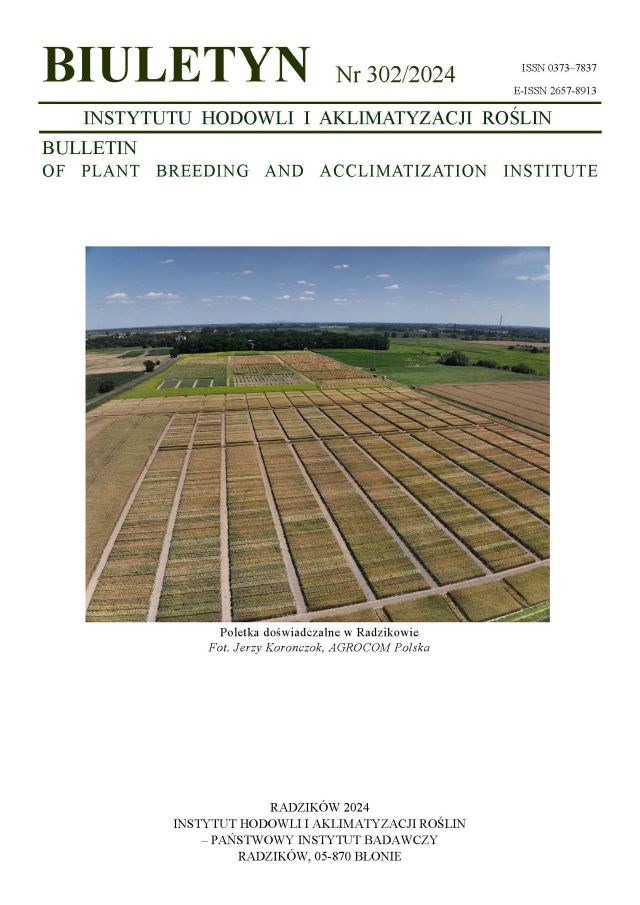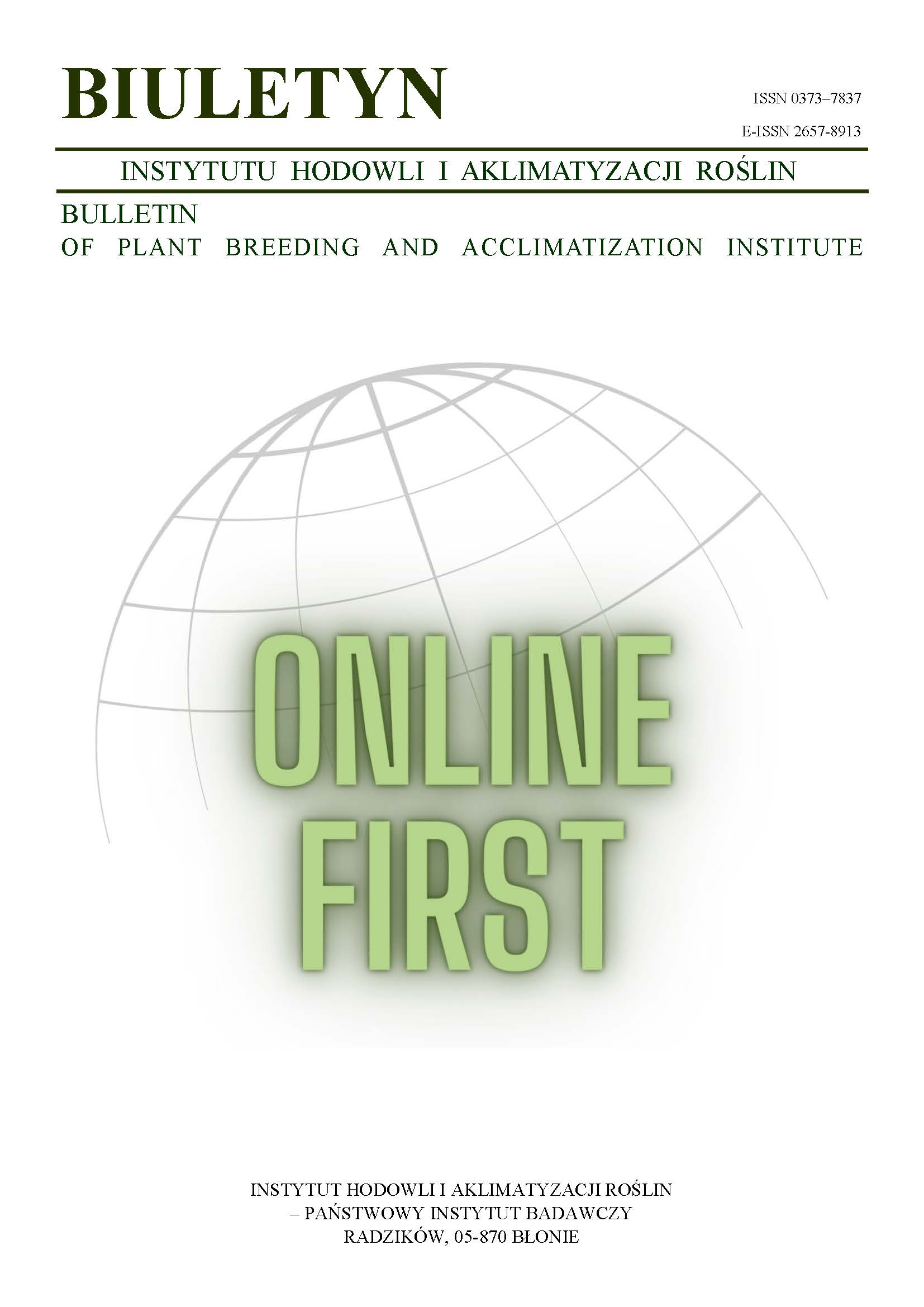Possibilities of using of introgressive hybridization in breeding of winter wheat T. aestivum L.
Part II. Effectiveness of improvements of spike characters and grain quality
Józef Pilch
j.pilch@ihar.edu.plZakład Oceny Jakości i Metod Hodowli Zbóż, Instytut Hodowli i Aklimatyzacji Roślin w Krakowie (Poland)
Abstract
This paper presents the possibilities of utilization of introgressive hybridization for breeding requirements of winter wheat T. aestivum L. by the production of initial materials. In the part II, breeding effects of introgressive hybridization, based on the genetic systems of wheat T. aestivum L., are presented. They include improvements of spike in respect of length (cm), number of spikelets, number of florets per spikelet, number of kernels, kernel weight (g) and the grain quality parameters as protein content (%), sedimentation index (ml) and falling number (s). The recorded values of these characters have never been reached in wheat breeding based on recombination within the species. The obtained materials are demonstrated, which can be used in winter wheat breeding programs. The most effective sources for improvement of the characters of spike and grain quality were the species T. boeoticum Boiss., T. timopheevii Zhukov. v. 5013, 5030, T. dicoccoides Schweinf., T. durum Desf. (cvs. Mirable, Khapli, Fuensemiduro, Mutico Mucur, DF624), Ae. speltoides Taush., L. perenne L. (cv. Anna) and E. giganteus L.
Keywords:
Triticum aestivum L., alien species, improvement, grain, introgressive hybridization, spike characters, quality parametersReferences
Anamthawat-Jonsson K. 1999. Variable genome composition in Triticum × Leymus amphiploids. Theor. Appl. Genet. 99 (7–8): 1087 — 1093.
DOI: https://doi.org/10.1007/s001220051313
Google Scholar
Anderson O. D., Litts J. C., Greene F. C. 1997. The L-gliadin gene family. I. Characterization of ten new wheat L-gliadin genomic clones, evidence for limited sequence conservation of flanking DNA and Southern analysis of gene family. Theor. Appl. Genet. 95: 50 — 58.
DOI: https://doi.org/10.1007/s001220050531
Google Scholar
Anderson O. D., Abraham-Pierce F. A., Tam A. 1998. Conservation in wheat high-molecular-weight glutenin gene promotor sequences: comparisons among loci and among alleles of the Glu-B1-1 locus. Theor. Appl. Genet. 96: 568 — 576.
DOI: https://doi.org/10.1007/s001220050775
Google Scholar
Ban T. 1997. Evaluation of resistance to Fusarium head blight indigenous Japanese species of Agropyron (Elymus). Euphytica 97: 39 – 44.
DOI: https://doi.org/10.1023/A:1003078109694
Google Scholar
Belea A., Sagi F. 1978. Evaluation of common wheats and interspecific Triticum hybrids for protein and lysine content. Cereal Res. Comm. Vol. 6, no. 1: 15 — 19.
Google Scholar
Bluthner W. D., Schumann E. 1988. Use of Aegilops and tetraploid wheat for wheat protein improvement. Hod. Rośl. Aklim. 32, 1–2: 203 — 206.
Google Scholar
Bojarczuk J. 2005. Pszenica T. durum Desf. w Polsce, genetyka, hodowla i wykorzystanie do produkcji makaronu. Biul. IHAR (w druku).
Google Scholar
Borghi B., Pogna N. E., Ambrogio E. 1998. Bread wheat. Italian Contribution to Plant Genetics and Breeding (Eds. G. T. Scarascia Mugnozza, M. A. Pagnotta), Univ. of Tuscia, Italy: 195 — 207.
Google Scholar
Branlard G., Autran J. C., Monneveux P. 1989. High molecular weight glutenin subunits in durum wheat (Triticum durum). Theor. Appl. Genet. 78: 353 — 358.
DOI: https://doi.org/10.1007/BF00265296
Google Scholar
Buerstmayr H., Lemmens L., Grausgruber H., Ruckenbauer P.1996. Scab resistance of international wheat germplasm.. Cer. Res. Comm. 24: 195 — 202.
Google Scholar
Cherkaoui S., Lamsaoui O., Chlyah A., Chlyah H. 2000. Durum wheat × maize crosses for haploid wheat production: Influence of parental genotypes and various experimental factors. Plant Breed. 119: 31 — 36.
DOI: https://doi.org/10.1046/j.1439-0523.2000.00433.x
Google Scholar
Ciaffi M., Benedeltelli S., Giorgi B., Porceddu E., Lafiandra D. 1991. Seed storage proteins of Triticum turgidum spp. dicoccoides and their effects on technological quality in durum wheat. Plant Breeding, 107: 309 — 319.
DOI: https://doi.org/10.1111/j.1439-0523.1991.tb00554.x
Google Scholar
Ciaffi M., Dominici L., Lafiandra D., Porceddu E. 1992. Seed storage proteins of wild wheat progenitors and their relationships with technological properties. Hereditas, 116: 315 — 322.
DOI: https://doi.org/10.1111/j.1601-5223.1992.tb00844.x
Google Scholar
Cygankiewicz A. 1997. Wartość technologiczna ziarna materiałów hodowlanych pszenicy ozimej i jarej na tle badań własnych i światowych. Biul. IHAR 204: 219 — 235.
Google Scholar
D’Ovidio R., Tanzarella O.A., Masci S., Lafiandra D., Porceddu E. 1992. RFLP and PCR analysis at Gli-1, Gli-2, Glu-1 and Glu-3 loci in cultivated and wild wheats. Hereditas 116: 79 — 85.
DOI: https://doi.org/10.1111/j.1601-5223.1992.tb00803.x
Google Scholar
D’Ovidio R, Simeone M., Masci S., Porceddu E. 1997. Molecular characterization of a LMW-GS gene located on chromosome 1B and the development of primers specific for the Glu-B3 complex locus in durum wheat. Theor. Appl. Genet. 95: 119 — 126.
DOI: https://doi.org/10.1007/s001220050671
Google Scholar
Farooq S,. Iqbal N., Asghar M., Shah T. M. 1992. Intergeneric hybridization for wheat improvement. IV. Expression of salt tolerance gene(s) of Aegilops cylindrica in hybrids with hexaploid wheat. Cereal Res. Comm. 20, 1-2:111 — 118.
Google Scholar
Forde J., Malpica J. M., Halford N. G., Shevry P. R., Anderson O. D., Green F. C. (1985). The nucleotide sequence of a HMW glutenin subunit gene located on chromosome 1A of wheat (Triticum aestivum L.) Nucleic Acids Res. 13: 6817 — 6832.
DOI: https://doi.org/10.1093/nar/13.19.6817
Google Scholar
Friebe B., Raup W. J., Gill B. S. 1997. Alien sources for diseases and pest resistance in wheat improvement. In: Lelley T. (ed.). Current topics in plant cytogenetics related to plant improvement, Tulln-Austria: 63 — 71.
Google Scholar
Hsam S. L. K., Mohler V., Hartl L., Wenzel G., Zeller F. J. 2000. Mapping of powdery mildew and leaf rust resistance genes on the wheat-translocated chromosome T 1BL-1RS using molecular and biochemical markers. Plant Breed. 119: 87 — 89.
DOI: https://doi.org/10.1046/j.1439-0523.2000.00444.x
Google Scholar
Juhasz A., Larroque O.R., Tamas L., Hsam S. L. K., Zeller F. J., Bekes F., Bedo Z. 2003. Bankuti 1201-an old Hungarian wheat variety with special storage protein composition. Theor. Appl. Genet. 107: 697 — 704.
DOI: https://doi.org/10.1007/s00122-003-1292-2
Google Scholar
Kaczyński L. 2002. Pszenica ozima. Lista opisowa odmian 2002. COBORU, Słupia Wielka: 20 — 35.
DOI: https://doi.org/10.1038/nbt0102-35
Google Scholar
Kazman M. E., Lein V., Robbelen G. 1997. The 1BL-1RS translocation in recently developed European wheats. In: Lelley T. (ed.). Current topics in plant cytogenetics related to plant improvement, Tulln-Austria: 334 — 341.
Google Scholar
Khan I. A. 2000. Molecular and agronomic characterization of wheat — Agropyron Intermedium recombinant chromosomes. Plant Breed. 119: 25 — 29.
DOI: https://doi.org/10.1046/j.1439-0523.2000.00440.x
Google Scholar
Klockiewicz-Kamińska E., Brzeziński W. J. 1997. Metoda oceny i klasyfikacji jakościowej odmian pszenicy. Wiad. Odm. COBORU, Słupia Wielka, 67: 1 — 18.
Google Scholar
Kushnir U., Halloran G. M. 1984. Transfer of high kernel weight and high protein from wild tetraploid wheat (Triticum turgidum dicoccoides) to bread wheat with recombination. Euphytica 33: 249 — 255.
DOI: https://doi.org/10.1007/BF00022773
Google Scholar
Lange W., Jochemsen G. 1979. Use of wild emmer (Triticum dicoccoides, AA BB) in the breeding of common wheat (Triticum aestivum L. AA BB DD). Proc. Conf. Broadening Genet. Base Crops, Wageningen: 225 — 227.
Google Scholar
Lima-Brito J., Guedes-Pinto H., Harisson G. E., Heslop-Harisson J. S. 1996. Chromosome identification and nuclear architecture in triticale × tritordeum F1 hybrids. J. of Exp. Bot., Vol. 47, No. 297: 583 — 588.
DOI: https://doi.org/10.1093/jxb/47.4.583
Google Scholar
Mc Intosh R. A., Lagudah E. S. 2000. Cytogenetical studies in wheat. XVIII. Gene Yr 24 for resistance to stripe rust. Plant Breed. 119: 81 — 83.
DOI: https://doi.org/10.1046/j.1439-0523.2000.00449.x
Google Scholar
Pilch J. 1987. Substytucje i delecje heterochromatynowe chromosomów żyta (Secale cereale L.) oraz ich związek z niektórymi cechami użytkowymi pszenżyta heksaploidalnego. Hod. Rośl. Aklim. 30, 3–4: 1 — 52.
Google Scholar
Pilch J., Głowacz E. 1997. Międzygatunkowe i międzyrodzajowe krzyżowania jako sposób ulepszania cech kłosa w hodowli pszenicy heksaploidalnej Triticum aestivum L. Biul. IHAR 204: 15 — 31.
Google Scholar
Pilch J. 2002. Wartość technologiczna introgresywnych form pszenicy ozimej (Triticum aestivum L.). Biul. IHAR 223/224: 95 — 109.
Google Scholar
Pilch J. 2004. Wykorzystanie hybrydyzacji introgresywnej w podwyższaniu wartości technologicznej ziarna pszenicy ozimej Triticum aestivum L. Pam. Puł. 135: 247 — 257.
Google Scholar
Reeves C. D., Okita T. W. 1987. Analyses of L, B — gliadin genes from diploid and hexaploid wheats. Gene 52: 257 — 266.
DOI: https://doi.org/10.1016/0378-1119(87)90052-7
Google Scholar
Rogers W. J., Rickatson J. M., Sayers E. J., Law C. N. 1990. Dosage effects of chromosomes of homoeologous groups 1 and 6 upon bread-making quality in hexaploid wheat. Theor. Appl. Genet. 80: 281 — 287.
DOI: https://doi.org/10.1007/BF00224399
Google Scholar
Rogers W. J., Miller T. E., Payne P. I., Seekings J. A., Sayers E. J., Holt L. M., Law C. N. 1997. Introduction to bread wheat (Triticum aestivum L.) and assessment for bread-making quality of alleles from T. boeoticum Boiss ssp. Thaoudar at Glu-A1 encoding two high-molecular-weight subunits of glutenin. Euphytica 93: 19 — 27.
DOI: https://doi.org/10.1023/A:1002991206350
Google Scholar
Rubiales D., Ballesteros J., Martin A. 1992 Resistance to Septoria tritici in Hordeum chiloense × Triticum spp. amphiploids. Plant Breed. 109: 281 — 286.
DOI: https://doi.org/10.1111/j.1439-0523.1992.tb00186.x
Google Scholar
Sao Q. Q., Deng W. Y., Lin X. Y. 1989. Wide crossing and gene transfer methods between species. In: Mujeeb-Kazi A., Sitch A.L. (eds). Review of Advances in Plant Biotechnology 1985–1988., CIMMYT-Mexico: 115 — 131.
Google Scholar
Schlegel R. 1997. Current list of wheats with rye introgressions of homoeologous group 1. 2nd update. Wheat Inf. Service No. 84: 64 — 69.
Google Scholar
Szafer W., Kulczyński S., Pawłowski B. 1967. Rośliny polskie. Wyd. PWN Warszawa: 930 – 931.
Google Scholar
Szwed-Urbaś K., Segit Z., Mazurek H. 1997. Parametry jakościowe ziarna krajowych linii pszenicy twardej (Triticum durum Desf.). Biul. IHAR 204: 129 — 140.
Google Scholar
Turchetta T., Ciaffi M., Porceddu E., Lafiandra D. 1995. Relationship between electrophoresis pattern of storage proteins and gluten strength in durum wheat landraces from Turkey. Plant Breed. 114: 406 — 412.
DOI: https://doi.org/10.1111/j.1439-0523.1995.tb00821.x
Google Scholar
Trottet M., Dosba F. 1983. Analyses cytogenetique et comportement vis-a-vis de Septoria nodorum d“ hybrides Triticum sp. × Aegilops squarrosa et de leurs descendances. Agronomie 37: 659 — 664.
DOI: https://doi.org/10.1051/agro:19830707
Google Scholar
Vallega V., Mello-Sampayo T. 1987. Variation of high-molecular-weight glutenin subunits amongst cultivars of Triticum turgidum L. from Portugal. Euphytica 3: 755 — 762.
DOI: https://doi.org/10.1007/BF00051858
Google Scholar
Zeven A. C., Waninge J. 1986. The degree of similarity backcross lines of Triticum aestivum cultivars Manitou and Neepawa with Aegilops speltoides accessions as donors. Euphytica 35: 677 — 685.
DOI: https://doi.org/10.1007/BF00028575
Google Scholar
Zillman R.R., Bushuk W. 1979. Wheat cultivar identification by gliadin electrophoregrams. III. Can. J. Plant Sci. 59: 287.
DOI: https://doi.org/10.4141/cjps79-048
Google Scholar
Authors
Józef Pilchj.pilch@ihar.edu.pl
Zakład Oceny Jakości i Metod Hodowli Zbóż, Instytut Hodowli i Aklimatyzacji Roślin w Krakowie Poland
Statistics
Abstract views: 51PDF downloads: 33
License
Copyright (c) 2005 Józef Pilch

This work is licensed under a Creative Commons Attribution-ShareAlike 4.0 International License.
Upon submitting the article, the Authors grant the Publisher a non-exclusive and free license to use the article for an indefinite period of time throughout the world in the following fields of use:
- Production and reproduction of copies of the article using a specific technique, including printing and digital technology.
- Placing on the market, lending or renting the original or copies of the article.
- Public performance, exhibition, display, reproduction, broadcasting and re-broadcasting, as well as making the article publicly available in such a way that everyone can access it at a place and time of their choice.
- Including the article in a collective work.
- Uploading an article in electronic form to electronic platforms or otherwise introducing an article in electronic form to the Internet or other network.
- Dissemination of the article in electronic form on the Internet or other network, in collective work as well as independently.
- Making the article available in an electronic version in such a way that everyone can access it at a place and time of their choice, in particular via the Internet.
Authors by sending a request for publication:
- They consent to the publication of the article in the journal,
- They agree to give the publication a DOI (Digital Object Identifier),
- They undertake to comply with the publishing house's code of ethics in accordance with the guidelines of the Committee on Publication Ethics (COPE), (http://ihar.edu.pl/biblioteka_i_wydawnictwa.php),
- They consent to the articles being made available in electronic form under the CC BY-SA 4.0 license, in open access,
- They agree to send article metadata to commercial and non-commercial journal indexing databases.
Most read articles by the same author(s)
- Józef Pilch, Effectiveness of HMW — glutenin gene Glu-1 introgressions in bread-making quality improvement of cereals — a review , Bulletin of Plant Breeding and Acclimatization Institute: No. 243 (2007): Regular issue
- Józef Pilch, Introgressions of genes from taxonomically related species in improvement of wheat Triticum aestivum L. and other cultivated plants , Bulletin of Plant Breeding and Acclimatization Institute: No. 260/261 (2011): Regular issue
- Józef Pilch, Using genes of diploid, tetraploid and hexaploid species of wheat Triticum L. in the varieties of hexaploid wheat Triticum aestivum L. , Bulletin of Plant Breeding and Acclimatization Institute: No. 262 (2011): Regular issue
- Józef Pilch, Genetic possibilities of grain quality improvement of winter wheat Triticum aestivum L. in the effect of introgressive hybridization with Triticum durum Desf. , Bulletin of Plant Breeding and Acclimatization Institute: No. 236 (2005): Regular issue
- Józef Pilch, Possibilities of using of introgressive hybridization in breeding of winter wheat T. aestivum L. , Bulletin of Plant Breeding and Acclimatization Institute: No. 235 (2005): Regular issue
- Józef Pilch, Effect of the A and B genomes Triticum durum Desf. on bread-making quality in winter wheat Triticum aestivum L. , Bulletin of Plant Breeding and Acclimatization Institute: No. 230 (2003): Regular issue
- Józef Pilch, Genetic determination of the morphological traits of a spike of wheat (Triticum aestivum L.) , Bulletin of Plant Breeding and Acclimatization Institute: No. 228 (2003): Regular issue














